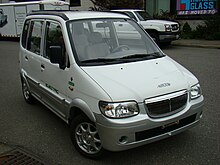
A hybrid vehicle is one that uses two or more distinct types of power, such as submarines that use diesel when surfaced and batteries when submerged. Other means to store energy include pressurized fluid in hydraulic hybrids.
Think Global was a Norwegian electric car manufacturer located in Bærum, which manufactured cars under the TH!NK brand. Production of the Think City was stopped in March 2011 and the company filed for bankruptcy on June 22, 2011, for the fourth time in 20 years. The company was bought soon after by Electric Mobility Solutions AS and production ceased in August 2012 with no more announcements regarding future production. As of October 2010, a total of 2,500 units had been manufactured at Oslo-based TH!NK's production facility.

The tZero is a hand-built electric sports car designed and built in very limited numbers by the U.S. pioneering company AC Propulsion in the mid 1990's. It was the inspiration and direct predecessor of the Tesla line of electric cars. The only part of the tZero that was not proprietary was the body that was based on the Piontek Sportech sports car, yet many parts of the body and interior were extensively modified. It consists of a Kevlar & Carbon Fiber reinforced body built over a custom hand-built reinforced stainless steel fabricated to package batteries space frame with double wishbone independent suspension and rack and pinion steering. AC Propulsion utilized their AC-150 drivetrain, a single-speed electric system with an overall gear ratio of 9:1.
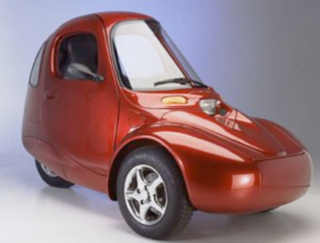
The Myers Motors NmG is a single-passenger, three-wheeled, battery electric vehicle designed specifically for commuting and city driving, produced from 1999 into the early 2010s. It was initially produced by Corbin Motors, and made to order after 2005 by Myers Motors. It is a personal electric vehicle (PEV).

A bumper is a structure attached to or integrated with the front and rear ends of a motor vehicle, to absorb impact in a minor collision, ideally minimizing repair costs. Stiff metal bumpers appeared on automobiles as early as 1904 that had a mainly ornamental function. Numerous developments, improvements in materials and technologies, as well as greater focus on functionality for protecting vehicle components and improving safety have changed bumpers over the years. Bumpers ideally minimize height mismatches between vehicles and protect pedestrians from injury. Regulatory measures have been enacted to reduce vehicle repair costs and, more recently, impact on pedestrians.
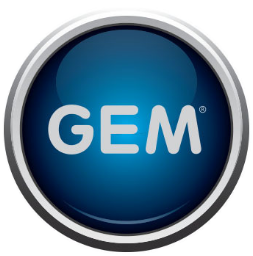
Global Electric Motorcars (GEM) is an American manufacturer specializing in neighborhood electric vehicles (NEVs) since 1998 and low-speed vehicles (LSVs) since 2001. By October 2015 the company had sold over 50,000 GEM battery-electric vehicles worldwide. Originally owned by Chrysler, GEM was acquired by Polaris Inc. in 2011. In January 2022, it became a wholly-owned subsidiary of Waev.

The Eliica is a supercar or an battery electric vehicle prototype or concept car first shown in 2004 and designed by a team at Keio University in Tokyo, led by Professor Hiroshi Shimizu. The 5.1 m (17 ft) car runs on a lithium-ion battery and can accelerate from 0–100 km/h (62 mph) in four seconds. In 2004, the Eliica reached a speed of 370 km/h (230 mph) on Italy's Nardò High Speed Track. The team's goal is to exceed 400 km/h (250 mph), breaking the record set by today's street-legal gasoline-powered vehicles.
Hybrid Synergy Drive (HSD), also known as Toyota Hybrid System II, is the brand name of Toyota Motor Corporation for the hybrid car drive train technology used in vehicles with the Toyota and Lexus marques. First introduced on the Prius, the technology is an option on several other Toyota and Lexus vehicles and has been adapted for the electric drive system of the hydrogen-powered Mirai, and for a plug-in hybrid version of the Prius. Previously, Toyota also licensed its HSD technology to Nissan for use in its Nissan Altima Hybrid. Its parts supplier Aisin offers similar hybrid transmissions to other car companies.

The CitiCar is a car produced from 1974 to 1977 by Sebring, Florida–based Sebring-Vanguard, Inc. After being bought out by Commuter Vehicles, Inc, Sebring-Vanguard produced the similar Comuta-Car and Comuta-Van from 1979 to 1982. Similarities to its exterior design can be spotted in the Danish Kewet and the later Norwegian Buddy electric car. Accounting for all CitiCar variants, a total of 4,444 units were produced up to 1979, the most since 1945 for an electric car assembled in North America until surpassed in 2011 by the Tesla.
An electronic speed control (ESC) is an electronic circuit that controls and regulates the speed of an electric motor. It may also provide reversing of the motor and dynamic braking. Miniature electronic speed controls are used in electrically powered radio controlled models. Full-size electric vehicles also have systems to control the speed of their drive motors.

A motorized bicycle is a bicycle with an attached motor or engine and transmission used either to power the vehicle unassisted, or to assist with pedalling. Since it sometimes retains both pedals and a discrete connected drive for rider-powered propulsion, the motorized bicycle is in technical terms a true bicycle, albeit a power-assisted one. Typically they are incapable of speeds above 52 km/h (32 mph), however in recent years larger motors have been built, allowing bikes to reach speeds of upwards of 72 km/h.

The fuel economy of an automobile relates to the distance traveled by a vehicle and the amount of fuel consumed. Consumption can be expressed in terms of the volume of fuel to travel a distance, or the distance traveled per unit volume of fuel consumed. Since fuel consumption of vehicles is a significant factor in air pollution, and since the importation of motor fuel can be a large part of a nation's foreign trade, many countries impose requirements for fuel economy.

The ZAP Xebra was an electric car launched in May 2006 in the United States market by ZAP corporation. It is classified legally as a three-wheel motorcycle in some jurisdictions, and is available in both sedan and pickup truck variants. It has seat belts. It does not have regenerative braking. The PK pickup has a dump bed, with fold-down sides and tailgate, that allows easy access to the batteries, controller, motor, and charger.
Apollo Energy Systems is a U.S. multinational alternative energy corporation headquartered in Pompano Beach, Florida, that develops, produces, and markets fuel cell power plants, electric propulsion systems, and alternative energy generation equipment. The company was founded by Robert R. Aronson in 1966 as the Electric Fuel Propulsion Corporation (EFP) in New Orleans, Louisiana. It later became known as the Electric Auto Corporation (EAC), and in 2001 changed to Apollo Energy Systems.

The Electrosport was a compact-sized electric vehicle based on the AMC Hornet that were converted by the Electric Fuel Propulsion Company (EFP) of Ferndale, Michigan.

The Coda is a four-door, four passenger electric car once manufactured by Coda Automotive. After being rescheduled several times, deliveries to retail customers in the United States began in March 2012. The car was sold exclusively in California and only 117 units were delivered by April 2013.

The Chevrolet Volt is a compact car that was produced by General Motors. The first generation of the Chevrolet Volt, it was manufactured at the Detroit facility until it was succeeded by the second and final generation of the Volt in 2015. It is a five-door liftback with a range-extending generator.

Harbilt Electrics Trucks was a British manufacturer of milk floats, other battery electric road vehicles and a variety of battery electric vehicles designed for industrial use rather than on the public roads. The company was formed in 1935 in Market Harborough, Leicestershire, and diversified into electric vehicles after the end of the Second World War. They had a good record at exporting their products, with notable successes in Switzerland and California. There were several changes of ownership during the 1970s and 1980s, and the company ceased to exist in 1989.
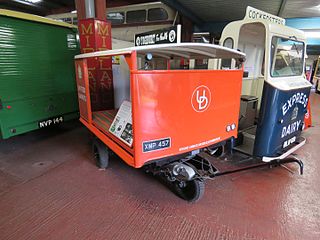
Graiseley Electric Vehicles were produced by the British company Diamond Motors Ltd of Wolverhampton. They had previously made motor cycles, but began producing battery-electric road vehicles (BERV) in the mid 1930s. They were best known for their three-wheeled pedestrian controlled vehicles, although they also produced conventional four-wheeled milk floats, and later manufactured industrial trucks. The company went into liquidation in the early 1960s, although the marque was used by two other companies until at least 1972.
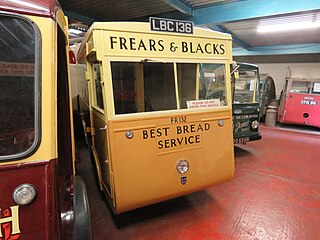
Partridge Wilson Engineering was a company established in Leicester, England in 1926. It initially made radios, and then battery chargers. In 1934 it began to build battery electric road vehicles, producing both cars and milk floats, which were marketed under the Wilson Electric marque. Vehicle production ceased in 1954, but it continued to make chargers and rectifiers. In 1974, it became part of Westinghouse Davenset Rectifiers Ltd, owned by Westinghouse Brake & Signal Company and in 1986 the Leicester site was closed, with manufacturing transferring to Chippenham. At least two of the commercial vehicles and three of the cars have been preserved.
